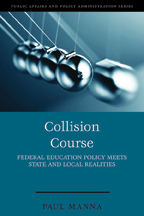 Schoolhouse of Cards: An Inside Story of No Child Left Behind and Why America Needs a Real Education Revolution
Schoolhouse of Cards: An Inside Story of No Child Left Behind and Why America Needs a Real Education Revolution
By Eugene Hickok
Rowman & Littlefield, 2010, $34.95; 183 pages.
Collision Course: Federal Education Policy Meets State and Local Realities
By Paul Manna
CQ Press, 2010, $32.95; 206 pages.
As reviewed by Nathan Glazer
Whatever Possessed the President? was the unlikely title of Robert C. Wood’s memoir of urban policy during the 1960s. The same thought springs to mind in reading these two books on the shaping and progress of the No Child Left Behind (NCLB) legislation, the great expansion of federal education policy effected during George W. Bush’s first year in office. One wonders not only what he and his advisers could have been thinking, but what the lawmakers who implemented NCLB could have been thinking. Its aims were unbelievably ambitious—every child to be proficient in reading, mathematics, and science for the appropriate grade level by 2014; an array of required tests in every state for grades 3 through 8 and in high school; the elimination of persistent achievement gaps for minorities, those with limited English, children from low-income families, and perhaps even students with disabilities; graduated requirements to be imposed on schools and school districts that did not make “adequate yearly progress” (AYP) toward these goals; and much else.
Eugene Hickok reminds us that education was a major theme in the campaign of the Republican candidate for president in 2000, despite Republican skepticism about any major federal role in education. Elimination of the Department of Education had been a frequent note in the party’s rhetoric for decades. But under Governor Bush, Texas education had made great progress, according to the state’s own tests, although this achievement was disputed during the campaign. Bush cited this improvement as one of his major accomplishments, and he hoped to take the measures that had led to it national. Bush further had managed all this while Democrats controlled the Texas legislature. Indeed, NCLB, formally an expansion of the Elementary and Secondary Education Act of 1965, moved through Congress in 2001 with surprising bipartisan support. It radically implemented at the federal level a call for “accountability” in education, which had already led to substantial changes in many states.
Hickok, who served as undersecretary of education during the first George W. Bush administration, gives a detailed account of how the legislation and the key decisions were shaped. The president’s White House advisers played the dominant role; the secretary of education, Roderick Paige, former superintendent of the Houston schools, is not much in evidence, and neither is Hickok himself, despite his high office. He informs us that it was decided early on that accountability should be imposed on the individual school. To make the teachers accountable would not only have involved a statistical burden that states were not prepared to accept, but would have led to strong union resistance, which would have influenced the Democrats.
The administrative burdens at the federal and state levels, it can be imagined, were enormous. AYP was to be measured not only at the school level but for defined subgroups in each school. As a consequence for failure to make AYP, schools and school districts were required to undertake measures for improvement: To begin with, students would be allowed to move to any other school in the district or would get supplementary tutoring, and beyond that, in further years in failure, “corrective action” and “restructuring” would be required, by schools and school districts.
All this was spelled out in mind-boggling detail in the legislation: One can find a helpful summary in Collision Course. Paul Manna, a professor at William and Mary, is particularly oriented to the administrative problems the legislation created at the federal and state levels. Many states already required their own testing, which had to be conformed to federal requirements, and the federal government now required a huge amount of reporting by states of plans for implementation and, in time, test results. Inevitable “collisions” could be expected to occur, among federal and state, state and school district, school district and schools, with Department of Education officials enforcing the law, and elected officials responding to the local inability to fulfill federal requirements and trying to get relief from them. There were also conflicts among top officials in the Department of Education, though Hickok is curiously silent about his role.
One wonders how anyone informed about education could have expected the measures imposed on schools and school districts to have had great effect. The freedom to choose alternative public schools? In heavily minority urban areas, not to mention rural areas, there would have been few or no superior alternative public schools with available seats from which to choose, and few of those who became eligible to make this choice did so. In any case, freedom to choose among public schools was already widespread and one could see how minimal its influence was.
Manna meticulously and soberly reports on the statistics showing how few students who could did choose different schools, how many received tutoring—a good many more—and with what results, if any, for achievement. The “corrective action” required after the fourth year of missing AYP, and the “restructuring” required in the fifth and sixth year after missing AYP, have not for the most part occurred. But the current secretary of education says that 82 percent of schools may be expected not to reach AYP in 2010-11. Presumably many requirements in the law for schools in need of improvement for a number of years will simply not be upheld. Many school districts, on their own, such as New York City’s, undertake the kinds of “corrective action” and “restructuring” that the law calls for after a number of years of failing AYP, but without any great outcomes on achievement.
The most serious effects of NCLB I believe may be seen at the teaching level in the classroom. For the weaker inner-city schools, in particular, the required tests have come to dominate the curriculum (see “Inside the Testing Factory,” book reviews, Winter 2008). Reading and math instruction plays a dominant role in these schools and classrooms, with some positive results; social science and arts education have had to be shunted aside.
As many have pointed out, it is a good thing that NCLB has made student academic achievement a central concern nationally (see “Will NCLB Hit the Wall?” forum, Fall 2007). But many state tests set the “proficiency” bar low, the decision to mark schools as “proficient” or not is too crude, the AYP measure means that many good schools with less need to do better are pointlessly marked “in need of improvement,” and the remedial measures are insufficient. Should they be prescribed by the federal level in any case? The law needs a radical overhaul.
What is possible in the present Congress, so sharply divided and in which a good part of both parties might be happier to see NCLB dispensed with entirely? While Manna gives many suggestions for improvement, Hickok surprisingly calls for a radical and revolutionary overhaul of the whole education system to adapt to contemporary realities. Neither the lesser nor the larger suggestions will find many buyers in the current Congress.
Nathan Glazer is professor emeritus of sociology and education at Harvard University.
This article appeared in the Fall 2011 issue of Education Next. Suggested citation format:
Glazer, N. (2011). Cautionary Tale: Authors recount NCLB’s tortured history. Education Next, 11(4), 85-86.



